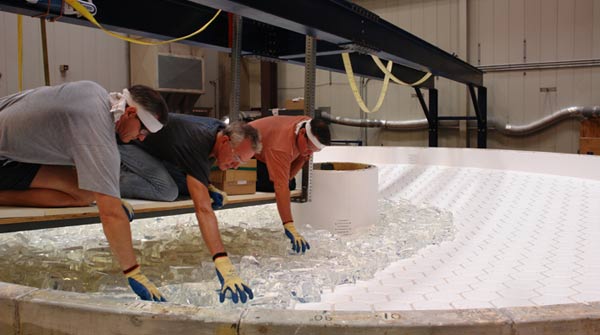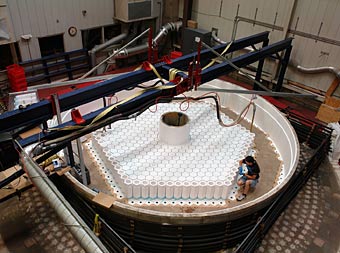With the casting of a 6.5-meter mirror in Arizona August 26, Mexican and American astronomers have taken the first step toward creating a new telescope that will survey infrared objects in the northern sky with unprecedented sensitivity.
The new mirror is destined for the planned San Pedro Mártir Telescope, which is expected to be built at the San Pedro Mártir Observatory in Baja California, Mexico.
When completed in 2017, the telescope will begin the Synoptic All-Sky Infrared Imaging Survey (SASIR) to look for faint infrared sources — ranging from dim, nearby stars to distant quasars — and flashes of infrared light from supernovae and other transient sources.
“Baja has a long tradition of telescopes, and the San Pedro Mártir Observatory is one of the best observatories in the world,” said Joshua Bloom, principal investigator for SASIR and an associate professor of astronomy at the University of California, Berkeley. “Now, we hope to build on the top of the mountain the world’s largest telescope dedicated to infrared astronomy.”
Project partners are the Universidad Nacional Autonoma de Mexico (UNAM), the University of California, the Instituto Nacional de Astrofisica, Optica y Electronica (INAOE), and the University of Arizona in Tucson.
The estimated cost of the telescope, $200 million, must be raised from private sources or from U.S. or Mexican government funding agencies. UNAM is opening a project office in Mexico City next month, and Bloom is optimistic that money for a preliminary design can be raised by the end of the year, with continued funding to enable ground breaking in 2013. The all-sky infrared survey should start in 2017 and last 4 to 5 years.
“With this unique combination of telescope size, infrared design and survey strategy, SASIR will help us discover everything from the Sun’s nearest neighbors to the most distant black holes in the universe,” Bloom said. “We believe that SASIR will have a tremendous scientific impact across all fields of astronomy.”
The project began in earnest with the casting August 26 of a “honeycomb” sandwich mirror 21.3 feet (6.5 meters) in diameter by the University of Arizona Steward Observatory Mirror Laboratory in Tucson. The mold inside the 2156° Fahrenheit (1180° Celsius) giant rotating furnace holds 22,500 pounds (10,200 kilograms) of E6 low expansion borosilicate glass produced by the Ohara Corporation in Japan. The furnace will spin at 7.4 revolutions per minute for 3 days so that the mirror achieves the desired focal ratio, f/1.25.
The mirror is made by flowing molten glass between 1,020 alumina-silica hexagonal hollow core boxes inside the tub mold. The hexagonal cores will be removed months from now, after the mirror blank has cooled and lifted off the furnace hearth, leaving the voids of the honeycomb glass structure. After cleaning, the finished honeycomb mirror will weigh an estimated 18,500 pounds (8,400 kg).
When equipped with the SASIR camera bearing the largest collection of infrared detectors to date, the San Pedro Mártir Telescope will offer an unprecedented view of the infrared night sky, Bloom said. The telescope will be able to detect objects 100 to 500 times fainter than the best infrared survey to date, the 5-year-old Two Micron All Sky Survey (2MASS).
The team hopes to find the most distant quasars, which are actively forming galaxies from the very early universe, and detect dim red stars that may comprise the missing mass in the neighborhood of the Sun. SASIR may also find Earth-sized planets around dim stars.
“This is a remarkably strong collaboration between two U.S. and two Mexican research groups,” said Jose Guichard, director general of INAOE. “The project, however, still welcomes other partners.”











